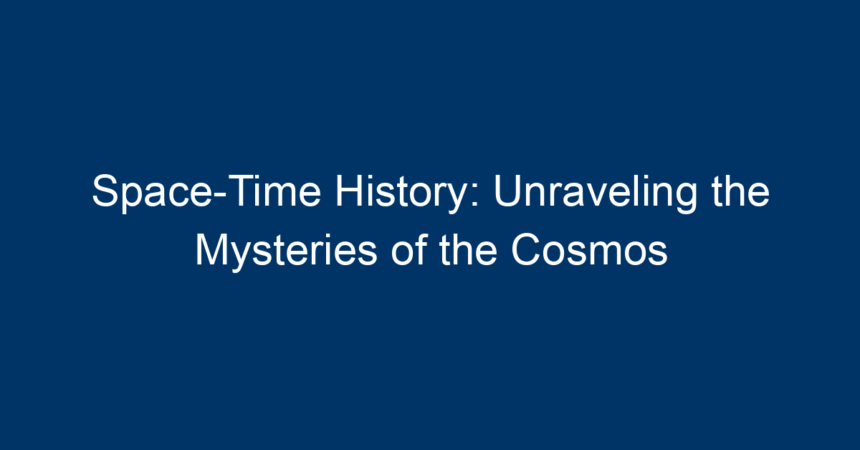The cosmos has always captivated humanity, from ancient astronomers gazing at the stars to modern physicists decoding the intricate fabric of the universe. At the heart of these explorations lies the concept of space-time history—a framework that interweaves the dimensions of space and time into a single entity. In this article, we will delve into the fascinating narrative of space-time history, exploring its origins, implications, and the ongoing quest to understand the universe’s mysteries.
Understanding Space-Time: A Foundation
What is Space-Time?
Space-time is a four-dimensional continuum that merges the three spatial dimensions (length, width, height) with the dimension of time into a single framework. This revolutionary concept, primarily developed by Albert Einstein through his theories of relativity, suggests that the universe isn’t merely a backdrop for events, but an active participant shaped by the forces of gravity and energy.
The Birth of Space-Time History
The concept of space-time history emerged from the need to explain observations that classical physics failed to clarify. Prior to Einstein, time was viewed as a separate, absolute entity. However, his theory of special relativity (1905) and subsequent development of general relativity (1915) revealed that time is relative and affected by speed and gravity.
The Role of Einstein
Einstein’s insights transformed our understanding of both time and space. He posited that massive objects like planets and stars warp the fabric of space-time, leading to what we perceive as gravity. This revelation laid the groundwork for modern cosmology and allowed scientists to explore the history of the universe in a new light.
The Key Features of Space-Time History
-
Curvature of Space-Time: Massive entities bend space-time, affecting the paths of nearby objects and light. This curvature explains phenomena such as orbits and gravitational lensing.
-
Time Dilation: The rate at which time flows can vary based on speed and gravitational potential. For instance, an astronaut traveling at high speeds experiences time more slowly than someone on Earth.
- Event Horizon: In the vicinity of black holes, the warping of space-time creates boundaries where gravity is so strong that nothing, not even light, can escape. This leads to the intriguing possibilities of singularities and the nature of information loss.
Exploring the Cosmos: The Expanding Universe
The Big Bang Theory
Central to the space-time history of the universe is the Big Bang Theory, which posits that the universe began as an infinitesimally small point roughly 13.8 billion years ago. This event marked the inception of space and time, leading to the rapid expansion of the cosmos. The remnants of this explosion are observable today in the cosmic microwave background radiation, providing essential clues about the universe’s early state.
Cosmic Expansion and Dark Energy
As the universe expanded, it began to cool, allowing matter to form stars, galaxies, and other celestial bodies. However, observations in the late 20th century revealed that this expansion is not slowing down as expected; instead, it is accelerating due to an enigmatic force known as dark energy. Dark energy comprises approximately 68% of the universe and remains one of the most significant mysteries in space-time history.
The Interplay of Space-Time and Quantum Mechanics
The Quest for a Unified Theory
While the theory of relativity explains the cosmic scales of space-time, quantum mechanics governs the subatomic realm. The challenge of reconciling these two paradigms has led to various theories, such as string theory and loop quantum gravity, which aim to bridge the gap between the very large and the very small.
Quantum Entanglement and Non-Locality
One of the most perplexing facets of quantum mechanics is entanglement, where particles become interconnected in ways that seem to violate the classical notions of space and time. This phenomenon hints at a more complex understanding of space-time, one that may reshape our grasp of causality and the fundamental nature of reality.
Technological Advances in Space-Time Exploration
Gravitational Wave Astronomy
In 2015, the detection of gravitational waves confirmed Einstein’s predictions about ripples in space-time caused by massive astronomical events, such as merging black holes. This groundbreaking discovery opened a new era of astrophysics, allowing scientists to observe cosmic events in ways previously thought impossible.
The Role of Advanced Telescopes
Advancements in telescope technology, such as the Hubble Space Telescope and the upcoming James Webb Space Telescope, have allowed astronomers to peer deeper into space-time history than ever before. These instruments enable researchers to study distant galaxies and seek answers to questions about the universe’s structure and evolution.
Philosophical Implications of Space-Time History
Time Travel: A Theoretical Possibility?
The concept of traveling through time has fascinated philosophers and scientists alike. While Einstein’s equations allow for the theoretical possibility of time travel, especially through wormholes or cosmic strings, practical implementation remains far beyond our current technological capabilities. Nevertheless, these theories spur discussions about causality, free will, and the nature of time itself.
The Nature of Reality
The exploration of space-time history compels us to reconsider our understanding of reality. If space and time are intertwined and elastic, what does that mean for our perception of existence? Insights gained from space-time studies challenge conventional beliefs, potentially leading to a unified worldview.
Conclusion: Navigating the Universe’s Mysteries
Space-time history is a captivating narrative that invites us to explore the cosmos and our place within it. As we continue to unravel these profound mysteries, the interplay of physics, technology, and philosophy will guide our understanding. Here are some actionable insights derived from this exploration:
-
Engage with Science: Reading books, watching documentaries, and attending lectures can deepen your understanding of space-time concepts.
-
Stay Informed: Follow the latest developments in cosmology and physics to grasp how our understanding of space-time history evolves.
-
Encourage Discussion: Engage in conversations about the implications of space-time, fostering an environment of curiosity and inquiry.
- Embrace the Mystery: Recognize that many questions remain unanswered; the journey of exploration is just as valuable as the answers we seek.
In the quest to understand space-time history, we uncover insights not only about the universe but also about ourselves and our connection to the cosmos. As we look to the stars, we are reminded of the infinite possibilities that lie ahead.




